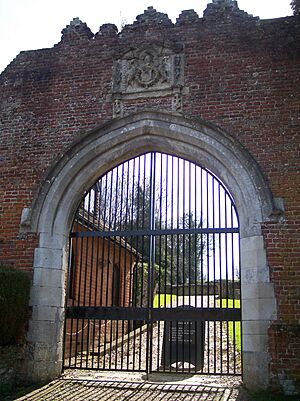Basing House facts for kids
Basing House was a huge palace and castle built in the Tudor style. It was located in the village of Old Basing in Hampshire, England. This grand building was once as big and fancy as Hampton Court Palace! Today, only parts of its underground levels, foundations, and old earth walls are left. These remains are protected as a Grade II listed building and a scheduled monument.
Contents
History of Basing House
Basing House began being built in 1531. It was designed as a new palace for William Paulet, 1st Marquess of Winchester. He was an important person who managed money for King Edward VI, Queen Mary I, and Queen Elizabeth I. A large barn nearby, called the 'Great Barn', was finished in 1534. This was just before King Henry VIII and Anne Boleyn came to visit.
How Basing House Was Built
When it was finished, Basing House had two main parts connected together. The "Old House" was built where an older castle's main tower used to be. It was inside strong earth walls and defenses. The "New House" was built a bit later, outside these defenses. A bridge and a gate connected the two parts through the walls. This connection became very important during the final battle for the fortress. The "New House" itself had about 360 rooms! It was mainly built to house all the people who traveled with the King or Queen when they visited.
Royal Visits to Basing House
Many important people visited Basing House over the years:
- King Edward VI visited on September 7, 1552, staying for three days.
- Queen Elizabeth I came in August 1560. She loved the house so much that she joked she would have married Lord Treasurer Paulet if he had been younger! She returned again in August 1569.
- In September 1601, Queen Elizabeth I hosted the French ambassador, the Duke de Biron. She hunted in the park with French noblemen and even knighted 11 men.
- King James I visited in August 1603.
- Queen Anne of Denmark stayed in September 1603. There was dancing, and an older nobleman, the Earl of Nottingham, became engaged to a much younger woman, Margaret Stewart.
By 1629, the 5th Marquess, John Paulet, decided to make the house smaller. The family moved out, and the house was closed for several years. The previous Marquess's parties had almost made the family run out of money. The huge brick house also had problems like broken windows and leaky roofs.
The English Civil War and Basing House
When the English Civil War started in 1642, the 5th Marquess, John Paulet, supported King Charles I. Because of this, the parliamentary army tried to capture Basing House three times. The King's supporters, called Royalists, managed to stop the first two attacks.
The Siege of Basing House
The final attack began in August 1645. Colonel John Dalbier and 800 soldiers surrounded the house. The soldiers inside, called the garrison, bravely held out. More enemy soldiers arrived, but the garrison still fought on. Then, Oliver Cromwell, a powerful leader of the parliamentary army, arrived with heavy cannons.
By October 14, 1645, the "New House" was captured, and the defenses of the "Old House" were broken. The final attack happened across the link from the New House. Many valuable items were stolen, and a fire destroyed the building. Several priests who had hidden in the cellar also died in the fire. The attack itself was over in just 45 minutes, but the fires burned for up to nine hours!
To send a message to other supporters of the King, Cromwell returned to London. A special order was given that anyone could take bricks and materials from Basing House. Local villagers were encouraged to take these materials to reuse them in their own homes. This was unusual, as normally, people were just used to take buildings apart, not to keep the materials. Archeologists have found proof that the house materials were neatly sorted for people to take, not just a free-for-all.
John Paulet had his lands taken away and was sent to the Tower of London. He was accused of being disloyal to the king, but this charge was later dropped. The site of Basing House was given back to him by King Charles II. His son, Charles Paulet, 1st Duke of Bolton, became rich again because he supported William of Orange during the Glorious Revolution. This wealth was used to tear down what was left of Basing House. A new house was built nearby at Hackwood Park, which became the new home for the Marquesses of Winchester until 1794.
Location and What Remains Today
Basing House is located in the village of Old Basing. This is about one mile east of the town of Basingstoke in Hampshire, England. The house is near the upper part of the River Loddon.
Since 2014, the ruins and gardens have been open to the public. They are managed by Hampshire Cultural Trust. You can still see parts of the basement or lower ground floor. This includes the wine cellar, brick doorways, arched passages, bread ovens, and even some original plaster. There's also a vaulted tunnel. You can get there by walking along the riverside from a car park. A special project, supported by the UK Heritage Lottery Fund, has helped improve and fix up the site in recent years. The old Basingstoke Canal (which was used from 1788 to 1910) used to run around Basing House and through other parts of Old Basing.




